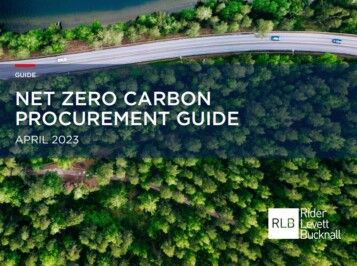We know that the drive to not only reduce but become net zero carbon (NZC) within the built environment is a major aim of all working in the industry whether on contractor side, as consultants like RLB, client side or within the supply chain.
Most organisations have pledged to become net zero carbon by 2050 in line with the Climate Change Act that commits a reduction of greenhouse gas emissions by at least 100% from 1990 levels and the Paris Agreement that calls for global warming to be no more than 1.5°C by 2030.
With the built environment estimated to account for over a third (38%[1]) of all global emissions, with 70% of an organisation’s emissions down to the supply chain, procurement is critical in how we achieve these targets – both in terms of the physical attributes of what we are procuring and the performance criteria of those assets.
RLB’s recently launched 2023 Net Zero Carbon Procurement Guide provides insight from across the industry on how sustainability is dealt with throughout the procurement process.
Here we highlight some of the key findings:
- 86% of those contractors that responded considered sustainability in their projects
However:
- Less than 25% of projects involve the contractor in impartial measurement of objectives at the point of completion and handover
- and 17% involve the contractor once the completed project has been operated for a number of months by the client (for example at the end of the Defects Period)
- Only 27% of tenders explicitly communicate the sustainability objectives
- 21% of projects have contract amendments specifically dealing with sustainability
- Less than 15% of projects undertake Whole Life Carbon assessment at procurement stage.
Although these figures are disappointing, the contractors we surveyed have the appetite to advance their commitments from the Government procurement advice (PPN 06/21) that governs NZC by 2050, with 40% working towards an earlier date of 2030.
We know that the real challenge is not in setting targets, but in achieving and evidencing them, and the report demonstrates that the gap between ambitions and achievement in the built environment is frequently linked to the conduct of procurement.
Contractors told us that the barriers to sustainable procurement include:
- Sustainability measures add cost and clients are not recognising this in their procurement practices
- They are being held back from delivering best practice in sustainability by client procurement practices
- The need to develop their own resources and people skills in sustainability to respond to clients’ sustainability drivers at procurement stages
- Disparate sustainability targets and measures often lead to lack of clarity.
One of the biggest challenges is how organisations will reduce their Scope 3 emissions, those generated from the indirect supply chain and the need to address the whole life cycle of a built asset. This includes how carbon may be used and eventually disposed of, and thinking about this at procurement stage, rather than mid or at the end of the lifecycle. All organisations need to start working with their contractors and supply chains to understand their Scope 3 emissions hotspots and address barriers to action.
Ultimately, there is a need to ensure that we plan NZC practices from the procurement process including:
- Research and pre-market engagement to ensure interventions are ambitious but achievable and commercially viable
- Defining sustainability targets for the projects and how they will be measured—understanding whether they can be linked to organisational targets, recognised standards or industry best practice
- Ensuring someone takes responsibility for delivering and pulling through sustainability ambitions at each construction stage
- Understanding and considering all appropriate delivery mechanisms for sustainability at each stage, from design specification through to contractual obligations.
To understand the challenge ahead and how to procure better net zero carbon outcomes, read RLB’s full NZC Guide here.
FURTHER INFORMATION:



